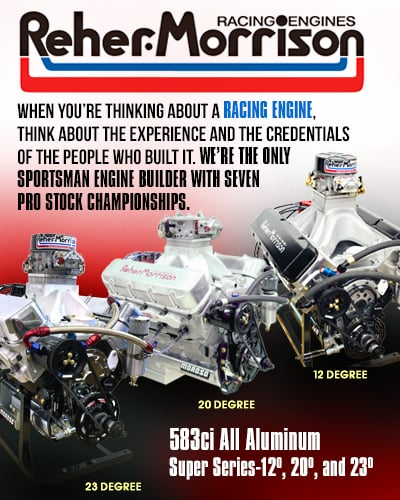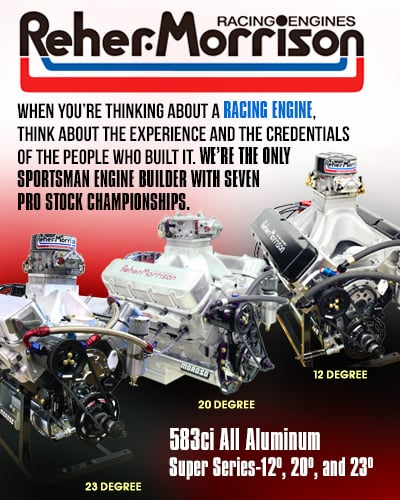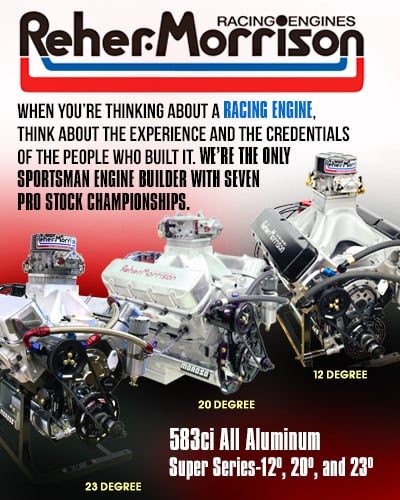FOR DECADES HE WROTE ABOUT WORLD CHAMPIONS, NOW THIS WRITER IS ONE
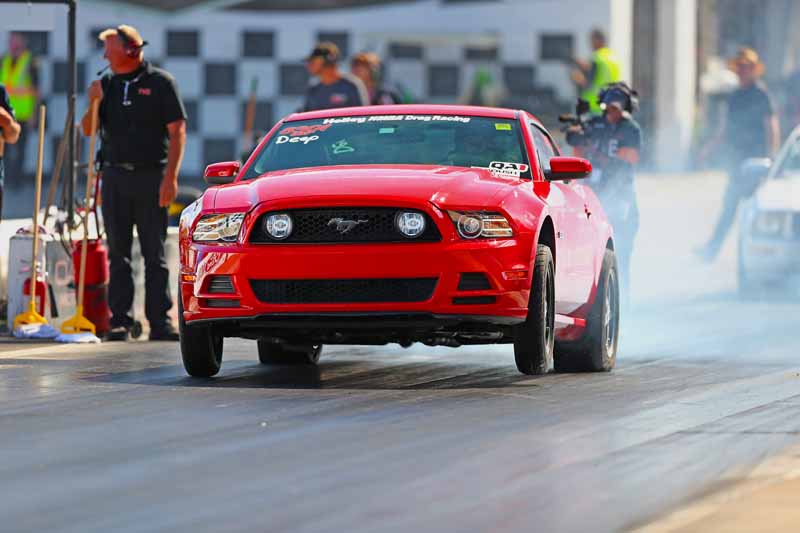
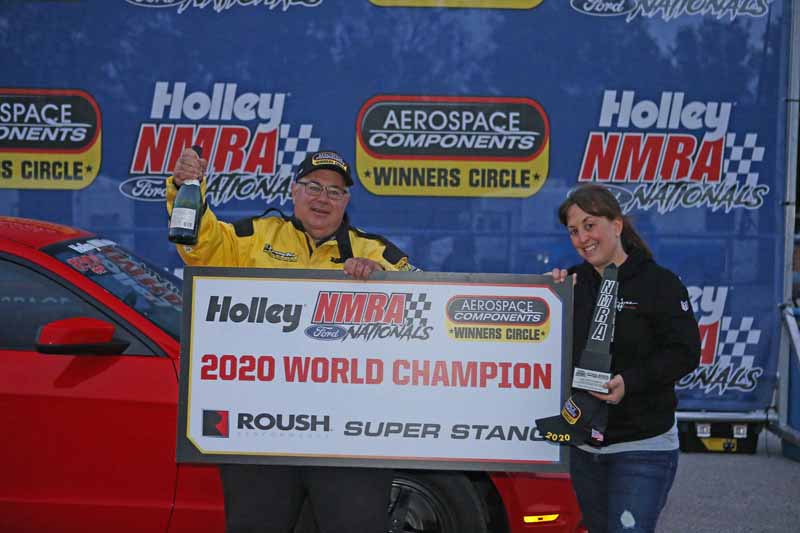
Now it’s time to turn the tables on the 55-year-old Rhode Island native, who recently captured the National Mustang Racing Association’s season championship in the Super Stang ranks. McKenna earned the No. 1 decal for his car in a manner befitting a champion: He KO’d the points leader in the second round, then disposed of his remaining two opponents to win the race and the title by a slim margin.
“I don’t want to say I think of myself as champ,” said McKenna, who lives in Avon, Ind. “It’s really just kind of a hobby thing.”
He rose to the top behind the wheel of a 2014 Mustang GT that he drives to every race — not a car he hauls in, or on, a trailer, but one that gets 20 miles to the gallon in its six- to seven-thousand miles of annual travels. The only big-buck alteration to the showroom Mustang is a supercharger that allows the engine to churn out 650 horsepower.
The car is, in part, the result of the relocation by McKenna and his wife, Jill, from southern California to Avon, about a mile and a half from his office at Lucas Oil Raceway.
McKenna said he “always wanted a cool car” and had only raced occasionally while he lived in the Golden State. He didn’t encounter any resistance from his wife, who’s the daughter of longtime NHRA Competition Eliminator racer John Caliendo. Jill, in fact, squared off against David Napp at the 1992 NHRA Summernationals in the first-ever race for Junior Dragsters.
It was Jill who planted the seed for Kevin’s racing endeavors with a simple question.
“She said, kind of half-jokingly, ‘When we move to Indy and we’re that close to the track, can we have a racecar?’ ” Kevin said.
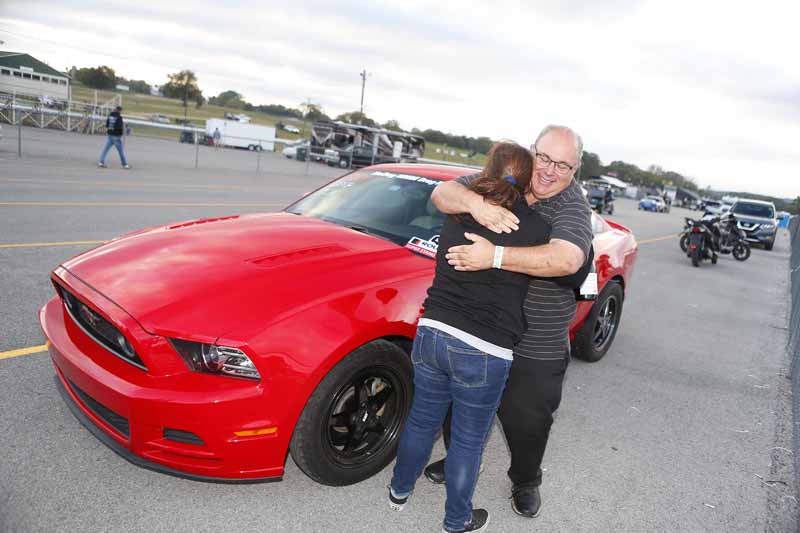
“He said, ‘Look, if you’re going to do this thing, a Mustang is the car you want. I know pretty much everybody in the industry. It won’t take a lot of work for us to make it fast,’ and it kind of snowballed from there,” McKenna said. “I ran the thing bone stock for two years. It was a high 12-second car — a lot of fun, drive it anywhere.”
Another skull session between McKenna and Smith led to its major upgrade and a two-second leap in performance in the quarter-mile. In January 2018, McKenna drove the car to New Smyrna Beach, Fla., where a VMP Performance supercharger was installed. The entire kit, parts and labor, “was about seven grand,” McKenna said.
“I drove the car in there on Monday morning at 8’clock, and by Tuesday at noon, we went from making about 350 horsepower to about 650. When you put tread radials on it, it’s a mid-10-second car,” he added.
“After talking to Evan, (the supercharger) was the best bang for the buck for what we wanted to do. I’m not a mechanical person at all, and I don’t want to own a truck or trailer or any of that stuff, so I wanted something to race that I didn’t have to work on. We wanted something that was reliable, and this was the best way to go.”
The other upgrades to the car include a one-piece carbon-fiber driveshaft to replace the two-piece factory unit, an FTI torque converter, and a set of QA1 shocks.
The Mustang, McKenna said, is a trusty piece by design.
“Ford built them knowing people were going to modify them to make them fast,” he said.

"So when I go to the races, I load in a small jack, wheels and tires, go to the race and swap them,” he said. “I’ve got a tuneup for the race for if I really want to get fast, I throw a coupla gallons of racing gas in there. You don’t really need to open the hood except to cool it off. … Knock on wood, it hasn’t let me down yet.”
In 2018, with the supercharger in place, he notched a win in the NMRA season opener, followed by a runner-up showing and a semifinals finish.
“I thought, ‘Oh, this is kinda cool,” he said, but those turned out to be the only races he was able to attend.
Last year, in 2019, his work schedule limited him to a lone NMRA outing.
This year, the onset of the COVID-19 pandemic actually worked in McKenna’s favor. Though the NMRA schedule was reduced from six races to five, its event dates happened to fall weekends on which NHRA was idle. That allowed McKenna to compete at Bradenton, Commerce, St. Louis, Martin and the finale at Bowling Green.
“I won’t call the pandemic a blessing,” McKenna said, “but when you’ve got time off — and even when (NHRA) got back to racing, the way the schedule fell, I said, ‘Well, I can go to all five, let’s give it a shot.’ ”
By the end of the season at Beech Bend Raceway, McKenna needed everything to go his way if he were to overhaul the 2019 Super Stang champ, Larry Firestone. Firestone defeated McKenna in the final round of the season-opening event at Bradenton, Fla.
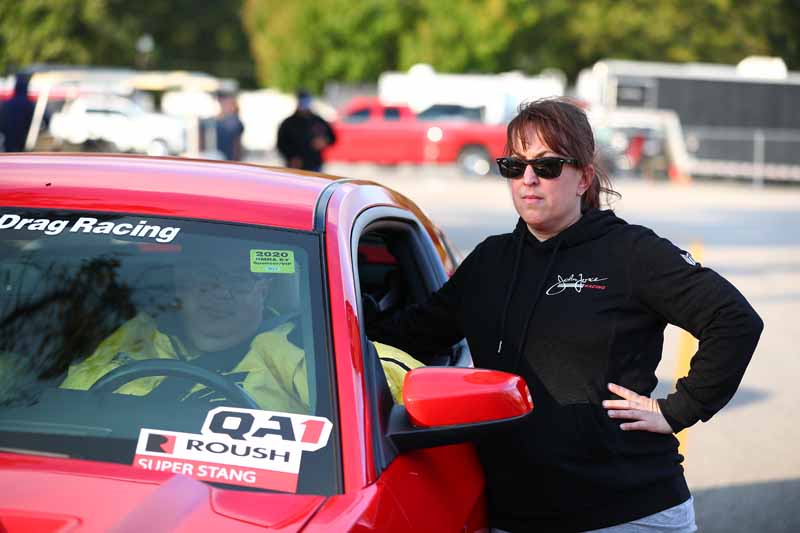
Even so, he was able to “hang around second, third in points” entering the finale, with Firestone in first and “essentially a three-round lead” in the standings.
“After St. Louis, I thought, ‘I’m pretty far back now, I don't think I can win this thing.’ I didn’t give it much thought, which was probably a good thing. I didn’t sit around dwelling on it,” McKenna said.
But at Beech Bend, everything aligned to give McKenna a shot at the championship. Firestone qualified No. 1 and McKenna No. 5, which set the stage for a second-round showdown. If McKenna could eliminate Firestone and win the event, he would just scrape by to earn the championship.
Firestone had a first-round bye while McKenna was able to win his duel. In their round-of-eight showdown, Firestone’s car had a mechanical issue and “rolled the beams,” which allowed McKenna to win and sustain his title hopes. In the semifinals, McKenna turned on the red bulb, but his opponent had fouled first, and that put McKenna in position to capture the title against Pete Espeut of Gambills, Md.
Super Stang racers compete on a ‘pro tree,’ but also race on a dial-in. Espeut got to see the green first, but his 2020 Mustang GT 500 didn’t move as quickly as he wanted for a .389-second reaction time. McKenna, meanwhile, cut a .022 light and ran 10.944 on his 10.76 dial to easily take down Espeut, who, in addition to a tardy light, broke out.
“It’s really hard to cut a light with one of those cars because they have this weird, dual-clutch stick-shift trans,” McKenna said of Espeut’s GT 500. “As soon as I left I thought, ‘Alright, I think I got him,’ and by half-track, I was thinking, ‘Try not to screw this thing up.’ It was one of those oh-my-god moments when the win light came on and you thought, ‘Geez, you didn’t just win the whole race, you won the whole thing.’ ”
But just barely. McKenna and Firestone won the same number of rounds of eliminations during the season, but McKenna earned the crown thanks to 10 points notched earlier in the season.
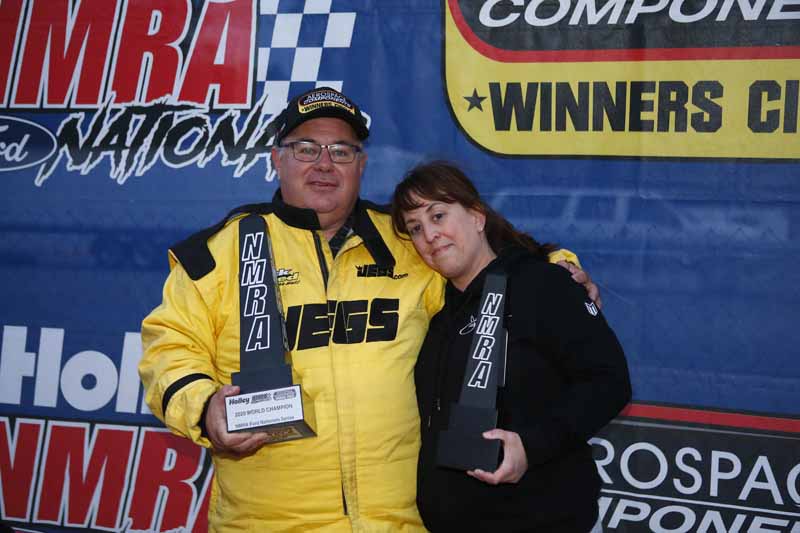
“You’re never sure until they hand you the trophy. After the final, you go to the tech area and they verify your contingency decals and things. The guy down there, I said something to him, I said, ‘I think I won it.’ He said, ‘I think so, too, but they’re up there counting the points.’
“So after we got done there, I went to the Winner’s Circle and was waiting in line behind a couple of the other guys, and (NMRA co-founder) Steve Wolcott had two trophies in his hand, a small one and a big one, and at that point I pretty much figured it was a done deal. It was a neat deal because it was the first time this year that Jill went with me. She had time off from work, and I had a couple of other friends show up. It was nice not just to do it, but to have a whole group there to hang with.”
The title marked the pinnacle of McKenna’s life in drag racing, which dates back to about 1980 following his family’s move from Rhode Island to the St. Petersburg, Fla., area. It was there that McKenna discovered Sunshine Dragway (now ShowTime Drag Strip) in nearby Clearwater and got hooked on drag racing. The eighth-mile track was owned by former Top Fuel racer Art Malone, and McKenna, who had only recently earned his driver’s license, went to Malone’s shop in Tampa to ask for a job at the track.
“He said, ‘You drove all the way here just for that? Be there Friday at 4 o’clock,” McKenna recalled. “I still have the uniform. Early ’80s, great education, you learned almost everything about operating a dragstrip. I worked staging lanes, tech, starting line, waterbox -- pretty much every job you could have there, I worked. It was hard work. Art was sometimes not an easy guy to work for, but you could hardly ask for a better education.”
Then, in 1984, McKenna saved enough money to fund his first trip to the NHRA U.S. Nationals at Indianapolis. He was working in the E.T. shack with Malone’s daughter, Pam, and he couldn’t contain his excitement about being able to attend Indy. She got wound up about it, too, and pleaded with her father to take her to Indy, to which he replied he didn’t want to attend if he didn’t have a racecar. But he put a call in to Don Garlits, a longtime friend who had captured the NHRA Top Fuel title in 1975.
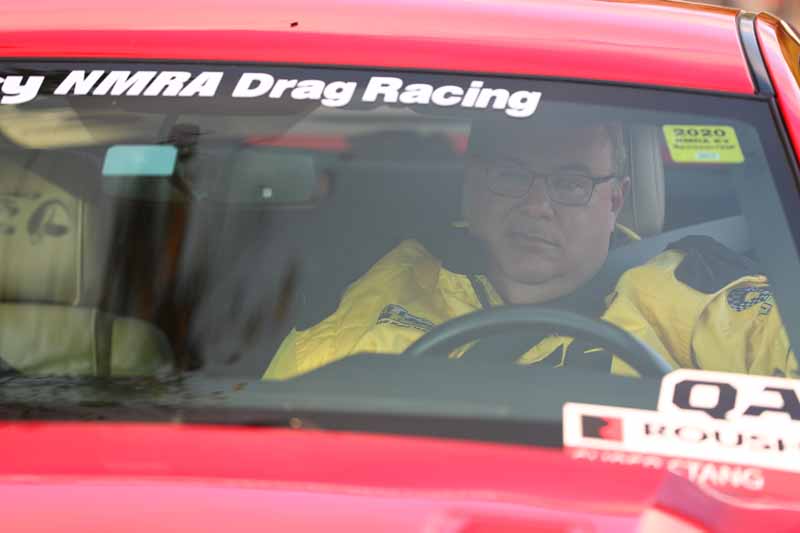
“None of that happens if I’m not going to Indy,” he said with a laugh. “If I wasn’t trying to impress Pam Malone, then Don Garlits is probably a one-time NHRA champ. I’ve had the chance to tell him that story, and he thought it was very funny.”
During his tenure at Sunshine, McKenna was offered the opportunity to get into drag racing full-time as a writer for United Racer. His boss there in Chicago was Ron Colson, who most notably drove the “Chi-Town Hustler” and “Hawaiian” nitro Funny Cars.
“I told him, ‘Look, I’m not a writer,’ ” McKenna said. “Colson said, ‘I don’t care. I need somebody that knows the sports, I can teach you whatever else,’ and it just kind of blossomed from there. It was all on-the-job training and trial and error.”
In later years, McKenna wrote a ‘how to drag race’ book that he now wishes he could revise with the on-track knowledge he’s attained.
“I talked to a lot of people to get information for that, but I’ve learned so much since then I almost wish I had a second shot at it -- now that you actually race more often and you’ve made all the stupid mistakes,” he said. “Every run, you look at something that you probably could’ve done better. A lot of things make more sense now. I think I have a much better understanding now of not just the mechanical part of it, but certainly the emotional part of racing, too.”
“Obviously in my job I have access to pretty much anyone from top-level pros to the best sportsman drivers, and I’ve always tried to pay attention when they talk. It’s actually been a tremendous help to be able to call someone like Dan Fletcher or Troy Williams Jr. and say, ‘Hey, I’m struggling with this’ or ‘I’m not sure how this works’ and have them explain it to you. You sort of take that level of access for granted until you actually need it.”

“My car is six years old, and you can do what I did with any Mustang, Camaro, Challenger. You wanna go buy a 10-year-old muscle car and do what I did, you’re not going to be into it for crazy, crazy money,” he said.
“There are a lot of people in Indy that come out to the track on a Wednesday night -- probably 30-40; in the summer, 50-60 -- that have newer muscle cars and they’re fun to drive. It really kind of goes with the whole NHRA philosophy of taking kids off the street and building the sport from the ground up. That’s something we’ve talked about quite a bit internally. … That part, to me, has been gratifying.”
His championship wares included some contingency money, “cool trophies that look kind of like the Washington Monument with a big, heavy granite base,” a ring and a jacket. Then there’s the anticipation of applying the number “1” decal to the windows of his Mustang.
“It was a nice haul. This class obviously fits in my budget. Five or six races, the entry fees are not exorbitant, and the maintenance on my car is very low,” he said.
“I have no idea what 2021 holds. I would like to go out and defend this, but there are occasionally overlap dates with NHRA races. … Fortunately my bosses have been very good about letting me travel and do this, and I hope that continues.”
Get all of your https://t.co/Reh86n8GFm apparel by visiting https://t.co/QR7z0rKzRO. The finest in quality as produced by @gosvaink and Greg Ozubko #CompetitionPlusApparel pic.twitter.com/pUsl6qgses
— Competition Plus (@competitionplus) October 27, 2020
























